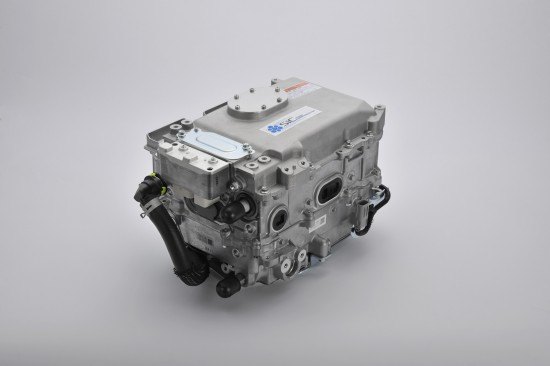Toyota Unveils Silicon Carbide Semiconductor Trial
Toyota unveiled its plans Wednesday to trial a new hybrid system using silicon carbide power semiconductors that could find its way into hybrids and EVs.
The trial will compare the new silicon carbide semiconductors with silicon units currently found in many a hybrid’s, FCV’s and EV’s power control unit, which are linked to a 20 percent loss in overall electric power. The aim is to increase powertrain efficiency by mitigating said losses through the new semiconductors.
The test subjects will be a Camry hybrid prototype and a fuel-cell bus. The bus trial began in early January, when Toyota started data collection on a setup featuring SiC diodes in the FCV’s voltage step-up converter. Meanwhile, the Camry — whose SiC components are in both the hybrid’s voltage step-up and inverter — will hit the road for a year beginning early next month. Both tests are being carried out in Toyota City, Japan.
Toyota hopes to have the SiC technology — developed in a partnership with Denso Corporation and Toyota Central R&D Labs, Inc. — ready for practical use as soon as possible.
Seattle-based writer, blogger, and photographer for many a publication. Born in Louisville. Raised in Kansas. Where I lay my head is home.
More by Cameron Aubernon
Latest Car Reviews
Read moreLatest Product Reviews
Read moreRecent Comments
- Irvingklaws 2005 Honda Accord at about 125k miles - oil change, replace bad starter (also intake gasket), front and rear brakes, state inspection, about $1200 at a local garage. Front brakes were replaced free under warrantee because they were done last year. 2015 Mazda CX-5 with 102k - Took to dealer to diagnose "clunk" on takeoff and transmission slow to engage. After pointing out an apparent transmission leak and that nearly every bushing/boot under the car is cracked and/or failing in their inspection video, service techs said everything "looked safe". They tightened the cowl bolts in an (unsuccessful) attempt to address the clunk, completely side-stepped the transmission leak ("...it's a sealed unit, we can't touch it except to replace it entirely...") and charged me $450. About $33k to replace it with a new '24 Forester. Will be working on diagnosing and reconditioning the Mazda myself in the coming days...🙂
- Ezekiel sani
- GS340Pete All new cars, repairs only, in chronological order:1996 Eagle Vision Tsi: $400 in repairs in 90k miles, and an under warranty fuel rail replacement. Did I get lucky? 2001.5 VW 'New Jetta' 1.8T auto. Transmission self-destructed within six months. "You're lucky this was under warranty, this would have been like 11 grand." Traded it immediately. Electrical gremlins started showing up too. 2002 Nissan Pathfinder. One $400 repair out of warranty, 02 sensor, in 100k miles.2012 Nissan Maxima, $0 in 24k.2013 Nissan Altima, $0 in 50k.2014 Dodge Charger AWD. $400 sensor out of warranty in 130k. Again, did I get lucky?
- 1995 SC The Ridgeline is too new so nothing yet.The FIAT needed a tire (nail in the sidewall) and a lower steering column cover and a set of wipers. Around 200 bucksThe 30 year old Thunderbird has been needy this year. Just did fuel injectors to add to belts, hoses, motor mounts, exhaust manifold gasket, shocks and a bunch of caps replaced on various modules.Rear main has developed a small leak so I will probably have the transmission gone through when I drop it. I want to do a few things to it. I have some upgraded front calipers too but they are junk yard parts I rebuilt. Like I said, it has been needy this year but old cars do that sometimes
- Tane94 Mini annual oil change at dealership, synthetic oil and new filter, $129 but sometimes $99 when a coupon is offered.






































Comments
Join the conversation
Dr. Hibbert: 'Was it carbon based, or silicone based? Homer: 'The second one, xylophone.'
In an industrial application a "drive" is used to operate a squirrel cage induction motor at different speeds. The same motor connected to normal 60Hz AC power will run at a speed determined by the number of poles the motor was built with. 7200 / number of poles = motor rpm. Most motors are 3600, 1800 and 1200, slower motors with more poles are generally less common. An AC variable frequency drive takes the incoming 60Hz AC power and rectifies and filters it using a capacitor bank, to a single phase DC bus. Transistors are used to reconvert this dC power to AC of any desired frequency. You observe a voltage to frequency ratio when driving the motor so the operational rpm range of the motor is limited. This is exactly what's being done in a Tesla, except they start with DC from a battery. Those power transistors, sometimes called IGBT's or insulated gate bipolar transistors, rapidly switch the power to synthesize a pure sine wave at a frequency to achieve the desire motor rpm. Every step in his conversion has losses, just as the transistors have a voltage drop across their junctions and dissipate this power as heat. So big heat sink and whatever cleaver means to keep he electronics cool. Medium voltage drives have huge losses, the air conditioner is as large as the drive itself in most cases. This is what I do for a living.